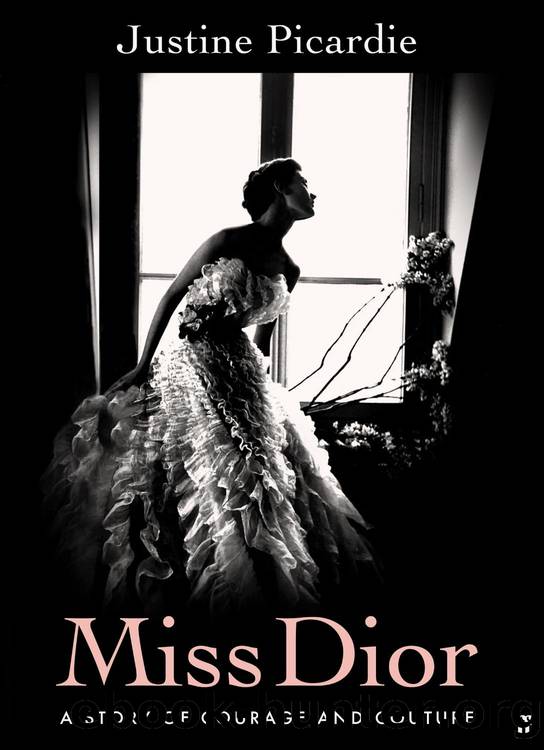Miss Dior by Justine Picardie

Author:Justine Picardie
Language: eng
Format: epub
Publisher: Faber & Faber
Published: 2021-09-15T00:00:00+00:00
Afterwards, Muggeridge attempted to draft an intelligence report on his evening with Chanel, but as he concluded in his autobiography: âreally there was nothing to say except that I was sure the épuration mills, however small they might grind, would never grind her â as indeed, proved to be the case.â
*
Against this backdrop of moral ambiguity, it is perhaps unsurprising that haute couture appeared to some observers to have gone astray in the months after Liberation. In his memoir, Christian Dior wrote that following his sister Catherineâs return to Paris, âAn unhappy chapter of my life had ended. On the fresh, still unblemished page before me, I hoped to record nothing but happiness.â Yet the aftermath of the war was impossible to ignore: âTraces of it were all around me â damaged buildings, devastated countryside, rationing, the black market, and less serious, but of more immediate interest to me, hideous fashions. Hats were far too large, skirts far too short, jackets far too long, shoes far too heavy ⦠For lack of other materials, feathers and veils, promoted to the dignity of flags, floated through Paris like revolutionary banners. But as a fashion I found it repellent.â The New York Times was no less scathing in January 1945, when Lucien Lelong commented in an interview that Paris continued to be the inspiration for couture. The newspaperâs response was dismissive: âTo be inspired by Paris at this time ⦠might mean reflecting the exaggerated psychoses of a city that is still emerging from the humiliation of defeat with the resentful sensitivity of a convalescent that is plaintively miserable without heat or light and buys its moments of comfort and gaiety on the black market.â
Carmel Snow, too, was bemused by the state of couture that she discovered on her return to Paris; always an astute interpreter of the ways in which fashion expresses the mood of the moment, she observed that it now âreflected the confusion the French had been going through since the Occupation. The people who were buying ⦠were the new black-market rich, with a vulgarity that was too dreadful to be believed. They were the people who had traded with the Germans and were still making fortunes trading among themselves, and they were the explanation of much that went on in Paris: the awful hats, the women in expensive clothes whom you wouldnât be seen dead with â¦â She did, however, admire Diorâs work at Lelong, and remained loyal to Balenciaga. Above all, she still had trust in the timeless art of Paris couture, and its place in what General de Gaulle had hailed in his Liberation speech as âla vrai France, la France éternelleâ.
Yet for all Carmel Snowâs consistent support of the French fashion industry in the pages of Harperâs Bazaar, a more powerful, if unexpected, boost came about as a consequence of philanthropy. Towards the end of 1944, Raoul Dautry, who had been appointed Minister of Reconstruction and Urban Development by General de Gaulle and was
Download
This site does not store any files on its server. We only index and link to content provided by other sites. Please contact the content providers to delete copyright contents if any and email us, we'll remove relevant links or contents immediately.
The wind in the willows by Kenneth Grahame(853)
AI 2041 by Kai-Fu Lee & Chen Qiufan(754)
The Love Songs of W.E.B. Du Bois by Honoree Fanonne Jeffers(721)
Pop Song by Larissa Pham(602)
The Dressmakers of Auschwitz by Lucy Adlington(565)
A Nation of Women by Luisa Capetillo(534)
The Sisters of Auschwitz by Roxane van Iperen(505)
Thirteen Lessons that Saved Thirteen Lives by John Volanthen(488)
The Queen's Agent by Cooper John(473)
Listen by Kathryn Mannix(470)
The Disappearance of Lydia Harvey by Julia Laite(464)
Power Moms by Joann S. Lublin(457)
Available by Laura Friedman Williams(453)
Cunning Women by Elizabeth Lee(443)
The Woman in Black: A Ghost Story by Susan Hill(441)
House of Kwa by Mimi Kwa(426)
Mother of All by Jenna Glass(417)
Stolen by Elizabeth Gilpin(404)
Life and Limb: (A Standalone Zombie Reverse Harem Romance) by Michaela Haze(397)
